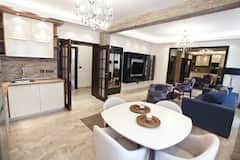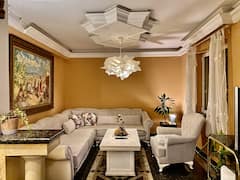The House of the National Assembly of Serbia, also known as National Parliament of Serbia, is a stunning monument of cultural significance that outlived 5 states since its founding. Located in Belgrade, the monument encompasses several architectural movements, features strong symbolism and introduces a short summary of Serbian and Yugoslavian history. By joining an hour-long guided tour that takes place once per month, you invest your time and effort well.
History of the National Assembly in a few words

Present Serbia is the sixth state in a row the National Assembly serves, and construction of the building was finished only during the time of the third. The founding stone was placed in 1907, when Belgrade was the capital of the Serbian Kingdom. The construction recommenced after the establishment of the Kingdom of the Serbs, Croats and Slovenes, after the First World War (1914 – 1918), and was completed in the Yugoslav Kingdom (1936), which was dissolved by the German occupation in the Second World War (1939 – 1945).
To find out why the House of the National Assembly was built just here, we need to get back to the first half of the 19th century. In October 1830, the first national assembly took place here, when Serbia achieved its limited autonomy from the Turkish Empire. The artistic value of the building was appreciated by the Germans, who established their headquarters here during the Second World War. There is also a legend according to which the construction of the Parliament dragged on because a prophecy stated that the king will die once it’s completed. The then King Aleksandar Karadjordjevic wasn’t that lucky. He was assassinated in Marseille, France, in 1934.
External features of the House of the National Assembly

From the outside, the National Assembly building is a harmonious unity of the High Renaissance and Ancient Greek styles, featuring Corinthian and Ionian columns, imposing cupola flanked with turrets, high portico accessible by a monumental staircase and densely distributed windows. Placed at each side atop the monument there is an additional cupola, while two angels guard the entrance above the doorway.
A sculpture in front of the entrance (in the photo) represents the human struggle with nature, sculpted by famous Serbian sculptor Toma Rosandic (1878 – 1959). At the bases of two flag pillars you can observe two-headed eagles, the Serbian symbol, with the coat of arms on their chests. Four Cs are, in fact, Cyrillic S letters, meaning Samo (Only) Sloga (Concord) Spasava (Saves) Srbina (the Serbs).
Vestibule of the cultural monument

As you enter the vestibule of the monument, you’ll be welcome by four great men of the Serbian, Croatian and Slovene histories. In the photo, you can see Karadjordje (Black George), who was the leader of the First Serbian Uprising (1804 – 1813), and the founder of the modern Serbian state and the Karadjordjevic dynasty. Other imposing sculptures represent Emperor Dusan the Mighty (1308 – 1355), the most powerful Serbian medieval ruler, King Tomislav, the first Croatian king, and Duke Kocelj of the Slovenes.
You’ll see the bust of a legendary Serbian politician Nikola Pasic (by Rosandic) in a niche. Nikola was the prime minister of the Serbian kingdom twice, the mayor of Belgrade as many times, and minister of foreign affairs. He was one of the Serbian leaders through two Balkan Wars (1912 and 1913) and the First World War.
The vestibule is crowned by the central cupola, whose base features bas-reliefs representing hallmarks of the monarchy (griffins) and of the Socialist Federal Republic of Yugoslavia, which existed from 1945 to 1992. Its six flames represent six Yugoslav republics, which were members of the union – Serbia, Croatia, Slovenia, Macedonia, Montenegro and Bosnia and Herzegovina (Bosnia and Herzegovina is one republic).
You might be interested in these Airbnbs!
Grand Hall of the House of the National Assembly

Grand Hall remains the same since the Parliament’s first session in 1936. It assumes the right side of the building, featuring a semicircle. The base of the Grand Hall is dotted with Doric columns, while the observation gallery is decorated with Ionian columns.
To the left, you can see the coat of arms of Serbia (as you certainly guessed, the two-headed eagle with four Cs) and the state and national (without the coat of arms in the middle) flags. Another worthy addition, or rather its copy, is the Sretenje constitution, the first Serbian constitution (1835). It was one of the most advanced European constitutions back then, based on the legacies of the French Revolution (1789 – 1799). Since the results of the Revolution weren’t appreciated by the European monarchies back then, the constitution was revoked under pressure of leading superpowers of that time – Russia, Austria and Turkey – after only a month and its creator was fired.
Small Hall of National Assembly's building

Small Hall, at the opposite side of the building from the Grand Hall, is where the Chamber of the Republics used to be in session. Conveniently, the Great Allegory of Work fresco (in the photo) introduces visitors to main industries of Yugoslavia, as well as to its main religions. Orthodox Christianity (Serbia, Montenegro, and Macedonia) is represented by the church in the upper left of the fresco; Catholic Christianity (Croatia, Slovenia) is illustrated by the Franciscan monastery and the mosque (upper right) symbolizes Islam, which was prevalent in Bosnia and Herzegovina.
If you look closely, you’ll notice throughout the gallery, in the arches above Ionian columns, paintings illustrating the Yugoslavian people in national costumes.
National Assembly’s Reception Hall

Besides the reception of visiting dignitaries, the Reception Hall is used for meetings. It combines features of Neoclassicist, Secessionist and Renaissance styles, and was conceived by Russian architect Nikolai Petrovic Krasnov. Female allegorical sculptures represent industry, agriculture, maritime, justice, crafts and education.
Other displayed halls and chambers

On your way through the House of the National Assembly, you’ll have an opportunity to visit the Diplomatic Chamber (in the photo), the Library, a couple of monumental staircases decorated with allegorical sculptures, hallways with portals framed in Ancient Greek temple-like door frames, etc. In one section of the hallway, various gifts from foreign delegations are displayed, consisting of handmade products characteristic to their countries of origin, various artwork, medals, figurines, etc.
While the well-equipped library (like those in Budapest and Vienna) used to be a temporary working place for Branislav Nusic (a celebrated Serbian humorist), in the Diplomatic Chamber (refer to the photo) you can see portraits of members of Serbian royal families (Karadjordjevic and Obrenovic), chronologically starting with Black George (central portrait). This Art Deco room also features one of the heaviest European chandeliers, with 36 light bulbs for the year of the National Assembly’s building completion.
Useful information on the House of the National Assembly
The free guided tour of the House of the National Assembly is combined with the New Palace tour, taking place every first Saturday in the month. The tour is organized in Serbian, although it can be organized in English for groups of 15 or more people. Individual visitors should first check by calling +381 11 302 62 73. After acquiring information, you can sign-up for the guided tour at +381 11 26 35 343 (the Tourist Organization of Belgrade). You should plan two hours of your time for both tours, each taking an hour.
History
Get Trip101 in your inbox
Unsubscribe in one click. See our Privacy Policy for more information on how we use your data























Create an account to